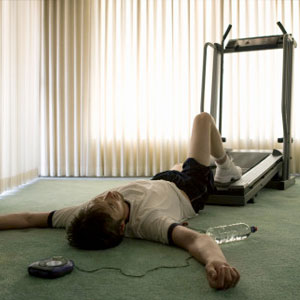Email from a client:
Nate: I’ve been hearing and seeing a lot in the popular press about High Intensity Training(HIT) and the results that can be achieved fairly rapidly. I was curious as to your take on this strategy, especially because I have some misgivings about starting such training and suffering an unnecessary injury. I figure it’s judicious to think about “things flying off”, especially when using major amounts of weight or cranking serious revs on the bike.
When you get a chance I’d appreciate your thoughts on this… Thanks! -Mark
This is a great question. No doubt when many people think of training that is specifically called “high intensity” images of youtube treadmill fails come to mind first. We’ve all seen people in the gym or on the internet who were doing too much, too soon, and paid dearly for it, usually through some embarassing combination of falling, smashing their face, or losing their pants in front of 45 women leaving their yoga class.
And while it’s easy to laugh at those people and move on with your life, high intensity interval training (HIIT) is not for the faint of heart, and i do see many people either injure themselves, or more commonly, hate the process so much that they never go back and try it again when they’re ready.
First of All, What is HIIT?
HIIT is basically the all powerful, all encompassing word that applies to working hard for a while, working less hard for a while, and repeating until nausea sets in. You’ll now find this word in every major health and fitness magazine, often along side the words ‘Tabata’, ‘sprints’, and ‘Peruvian Camel Urine’ (PCU is the new acai berry).
 Any type of exercise can (and has) been called HIIT, whether it’s track work, bench pressing, or pilates. Basically though, it involves pushing yourself into the anaerobic zone of exercise, which is roughly 80% – 90% of your max heart rate, then resting for a time before pushing back up into the anaerobic zone. Sessions can last from 4 minutes (Tabata style of 20 seconds hard, 10 seconds off) up to 30 minutes. Any more, and your body is liable to burn out.
Any type of exercise can (and has) been called HIIT, whether it’s track work, bench pressing, or pilates. Basically though, it involves pushing yourself into the anaerobic zone of exercise, which is roughly 80% – 90% of your max heart rate, then resting for a time before pushing back up into the anaerobic zone. Sessions can last from 4 minutes (Tabata style of 20 seconds hard, 10 seconds off) up to 30 minutes. Any more, and your body is liable to burn out.
Why is HIIT so Great?
There’s a reason this has become such a popular modality though. IT WORKS. It’s an amazing technique for burning mega-calories, while simultaneously increasing insulin sensitivity and human growth hormone production, which by themselves will make you leaner over time.
It’s also a good way to shorten your workouts, while making them more effective and increasing your work capacity. It’s pretty much a Win-Win-Win.
Well, Is it Safe?
The short answer is yes. It’s as safe as using a chainsaw, riding a bike, or doing the Harlem Shake underwater.

Anything can be dangerous if you’re doing it wrong, or without proper preparation. If you’ve never tried skateboarding before, nothing you do on a skateboard will actually be ‘safe’, even though it can be a safe and rewarding activity.
So make sure that you have a adequate base of aerobic exercise first before attempting to push yourself into the anaerobic zone. The widely accepted but slightly stupid way of determining what zone you’re in is based off of the max heart rate formula of 220 – your age. However, it’s important to self monitor, because after a while, and with this style of training, max HR will improve way beyond this formula. i.e. a 50 year old having a max heart rate of 190.
In order to make sure that you’re good to go on trying HIIT, make sure that you can at least reach 80% of your max HR based on the formula, and hold that for at least 1 minute. If you can’t do this, keep working at that level before trying something more intense. If this is easy, by all means start adding in more intense intervals.
How is it Done?
For best results, I recommend resting AT LEAST 2x as long as you work for. So that means if you’re working at 85% of your max HR for 30 seconds, take a 60 second break before starting again. This can be a lighter, slower version of the exercise you were doing, or it can be pure rest. I’m in the work hard, rest hard camp.
If you’d like to try this out, one of the easiest ways to adjust resistance and get a great workout without messing with too many buttons is to find a spin bike, and use that. Make sure you get a good 5 minute warmup at least and that your heart rate is elevated, and you have a light sweat going.
Start with 30 seconds of peddling as fast as you can with fairly heavy resistance, then 60 seconds of peddling slowly with very light resistance. If this is your first time doing HIIT, repeat 4x, rest, and move on. As you become more experienced, you can set time goals, or goals of finishing a certain number of rounds.
As you get stronger and better at this style of training, you can apply it to other exercises. Sprinting is a fan favorite, and one of the most impressive exercises for destroying fat, and building an athletic physique. You can also try this with Deadmill sprints (running on the treadmill with the motor off), front squats, or a super-set of opposite muscle group exercises like chest press and dumbbell rows.
Give it a try, let me know what you think. Leave any questions in the comments.
![]()









